Glockenspiel facts for kids
The glockenspiel ( glo-KƏN-shpeel; or Glocken: bells and Spiel: play) or bells is a percussion instrument consisting of pitched aluminum or steel bars arranged in a keyboard layout. This makes the glockenspiel a type of metallophone, similar to the vibraphone. The glockenspiel is played by striking the bars with mallets, often made of a hard material such as metal or plastic. Its clear, high-pitched tone is often heard in orchestras, wind ensembles, marching bands, and in popular music.
In the United Kingdom, the United States, and Canada, there is a form of glockenspiel called a bell lyre, bell lyra, or lyra-glockenspiel. The bell lyre is a form of glockenspiel commonly used in marching bands. It is played upright and has an extendable spike which is held on a strap. The player marches with the strap over his shoulder and plays the instrument upright with a beater. Another variation of the bell lyre exists which is held by a strap round the shoulders and back. This variation is played horizontally with two beaters as it does not need to be held upright. Since the middle of the 19th century this form of the instrument has also been used in military and civil bands in Germany, where it is called a Stahlspiel or Militär-Glockenspiel. The all-percussion Drum and lyre corps in the Philippines uses this as a main instrument.
History
Early glockenspiels were percussion instruments that produced notes via small bronze bells that were tuned with a drumstick. The bells were replaced by metal sound plates in the 17th century. In the 18th century the instrument was played using a keyboard that struck the bottom of each plate with a hammer. The use of mallets evolved during the 19th century.
Images for kids
-
A Mardi Gras musician playing a horizontal bell lyre
See also
 In Spanish: Glockenspiel para niños
In Spanish: Glockenspiel para niños








